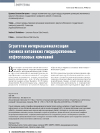Parallels and Meridians of Economy and Society (Strata and Routes)
DOI: 10.33917/es-1.199.2025.50-57
The author examines a “geodesic” model of the country’s socio-economic space, based on analogues of the geographical concepts of parallel and meridian as structural landmarks for an object’s location in the socio-economic space. The role of parallels is played by socio-economic strata, combining trajectories of the possible movement of agents without significantly increasing their status in the economy and society. The role of meridians is performed by routes that determine the possibilities of increasing the agent’s status without significantly changing the nature and location of his professional activity. This model can be used for navigation of socio-economic agents when moving in space, as well as for identifying current directions of socio-economic policy aimed at increasing the continuity and coherence of the socio-economic space of Russia. The geodesic model of socio-economic space, based on a grid of parallels and meridians, allows scaling and application not only to country systems, but also to other hierarchical socio-economic systems, including enterprises, cities, and sectors of the economy.
References:
1. Tambovtsev V.L. Institutsional’naya slozhnost’: novoe napravlenie izucheniya institutov? [Institutional Complexity: A New Direction for the Study of Institutions?]. Voprosy teoreticheskoy ekonomiki, 2023, no 2, pp. 22–24, DOI: 10.52342/2587-7666VTE_2023_2_22_34
2. Byrne D., Callaghan G. Complexity Theory and the Social Sciences. London & New York, Routledge, 2014.
3. Complex New World. Translating New Economic Thinking into Public Policy. Dolphin T., Nash D. (eds.). London: Institute for Public Policy Research, 2012.
4. Arthur W. Complexity and the Economy. Science, 1999, vol. 284, N 5411, pp. 107–109.
5. Bertalanffy L., von. General System theory: Foundations, Development, Applications. New York: George Braziller, Inc., 1968. 289 p.
6. Gavrilets Yu.N. Slozhnost’, upravlenie i informatsiya v sotsial’no-ekonomicheskikh sistemakh [Complexity, Governance and Information in Socioeconomic Systems]. Problemy teorii i praktiki upravleniya, 2016, no 12, pp. 39–49.
7. Lukin E.V. Regulirovanie mezhregional’nykh tsepochek dobavlennoy stoimosti: problemy analiza i modelirovaniya [Regulation of Interregional Value Chains: Problems of Analysis and Modeling]. Problemy prognozirovaniya, 2022, no 1, pp. 19–33, DOI: 10.47711/0868-6351-190-19-33
8. Orekhova S.V. Metodologicheskie osnovy opredeleniya institutsional’noy slozhnosti rynka [Methodological Foundations for Determining the Institutional Complexity of the Market]. Upravlenets, 2015, no 4, pp. 24–35.
9. Orekhova S.V. Teoreticheskaya model’ analiza institutsional’noy sredy otraslevykh rynkov [Theoretical Model for Analyzing the Institutional Environment of Industry Markets]. Teoreticheskaya i prikladnaya ekonomika, 2016, no 3, pp. 164–176.
10. Gastev Yu.A. Gomomorfizmy i modeli (logiko-algebraicheskie aspekty modelirovaniya) [Homomorphisms and Models (Logical and Algebraic Aspects of Modeling)]. Moscow, Nauka, 1975, 152 p.







